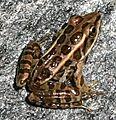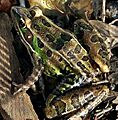List of frogs and toads of New Jersey facts for kids
New Jersey is home to many amazing creatures, including different kinds of frogs and toads! These amphibians are a special part of the state's wildlife. They live in various habitats, from forests to wetlands. Learning about them helps us understand and protect the natural world around us.
Contents
What are Frogs and Toads?
Frogs and toads are both types of amphibians. This means they can live both in water and on land. They start their lives in water as eggs, then hatch into tadpoles. As they grow, they change into their adult forms.
Key Differences Between Frogs and Toads
While they are related, frogs and toads have some differences.
- Skin: Frogs usually have smooth, moist skin. Toads often have dry, warty skin.
- Legs: Frogs tend to have long, powerful legs for jumping far. Toads have shorter legs for walking or hopping.
- Habitat: Frogs often stay closer to water. Toads can live further away from water.
Where Frogs and Toads Live in New Jersey
New Jersey has many different environments, which is great for amphibians. You can find frogs and toads in:
- Forests: Like the Pine Barrens, where some unique species live.
- Wetlands: Marshes, swamps, and bogs are perfect homes.
- Ponds and Lakes: Many species spend a lot of time in or near water.
- Backyards: Some common species can even be found in gardens.
Common Frogs in New Jersey
New Jersey is home to many interesting frog species. Here are a few you might encounter:
Northern Cricket Frog
The Northern cricket frog is one of the smallest frogs in New Jersey. It's known for its call, which sounds like crickets chirping. These tiny frogs are often found near ponds and slow-moving streams.
Pine Barrens Tree Frog
The Pine Barrens tree frog is a special frog found mostly in the New Jersey Pine Barrens. It has bright green skin with purple stripes. This frog is quite rare and needs clean, acidic water to survive.
Gray Treefrogs
There are two types of gray treefrogs in New Jersey: Cope's gray treefrog and the Gray treefrog. They can change their skin color to match their surroundings. This helps them hide from predators. They are often found in trees and shrubs.
Spring Peeper
The Spring peeper is a small frog with a distinct "X" mark on its back. Its loud, high-pitched "peep" is one of the first sounds of spring. You can hear them calling from wetlands and forests.
American Bullfrog
The American bullfrog is the largest frog in New Jersey. It can grow quite big and has a deep, booming call. Bullfrogs are often found in large ponds and lakes. They are strong swimmers and good hunters.
Common Toads in New Jersey
New Jersey also has several types of toads. Toads are generally more terrestrial than frogs, meaning they spend more time on land.
American Toad
The American toad is one of the most common toads in New Jersey. It has bumpy, brownish skin and can be found in many different habitats. You might even see one in your backyard! They eat insects and other small creatures.
Fowler's Toad
Fowler's toad looks similar to the American toad but has different markings. It prefers sandy areas and can often be found near beaches or in the Pine Barrens. Its call sounds like a short, loud "waaaah."
Eastern Spadefoot
The Eastern spadefoot is a unique toad that spends most of its life underground. It has a hard, spade-like growth on its back feet. This helps it dig backwards into the soil. They only come out to breed, usually after heavy rains.
Life Cycle of Frogs and Toads
The life cycle of frogs and toads is a fascinating journey.
- Eggs: They start as tiny eggs laid in water, often in large clumps or long strings.
- Tadpoles: The eggs hatch into tadpoles, which are aquatic larvae. Tadpoles breathe with gills and eat algae.
- Metamorphosis: As tadpoles grow, they begin to change. They develop legs, their tails shrink, and their gills are replaced by lungs.
- Adults: Once fully developed, they become adult frogs or toads. They can then live on land and in water, and the cycle begins again.
Why are Frogs and Toads Important?
Frogs and toads play a vital role in their ecosystems.
- Pest Control: They eat many insects, including mosquitoes, which helps control pest populations.
- Food Source: They are also a food source for other animals, like snakes, birds, and raccoons.
- Environmental Health: Because their skin is sensitive, they are good indicators of environmental health. If frog populations are declining, it can signal problems with pollution or habitat loss.
How Can We Help Frogs and Toads?
Protecting frogs and toads is important for a healthy environment. Here are some ways you can help:
- Protect Habitats: Support efforts to protect wetlands, forests, and other natural areas where they live.
- Reduce Pollution: Avoid using harmful chemicals in your yard that can wash into their habitats.
- Create Ponds: If you have space, creating a small pond in your yard can provide a home for them.
- Learn More: The more you learn about these amazing creatures, the better you can help protect them.
Images for kids
















